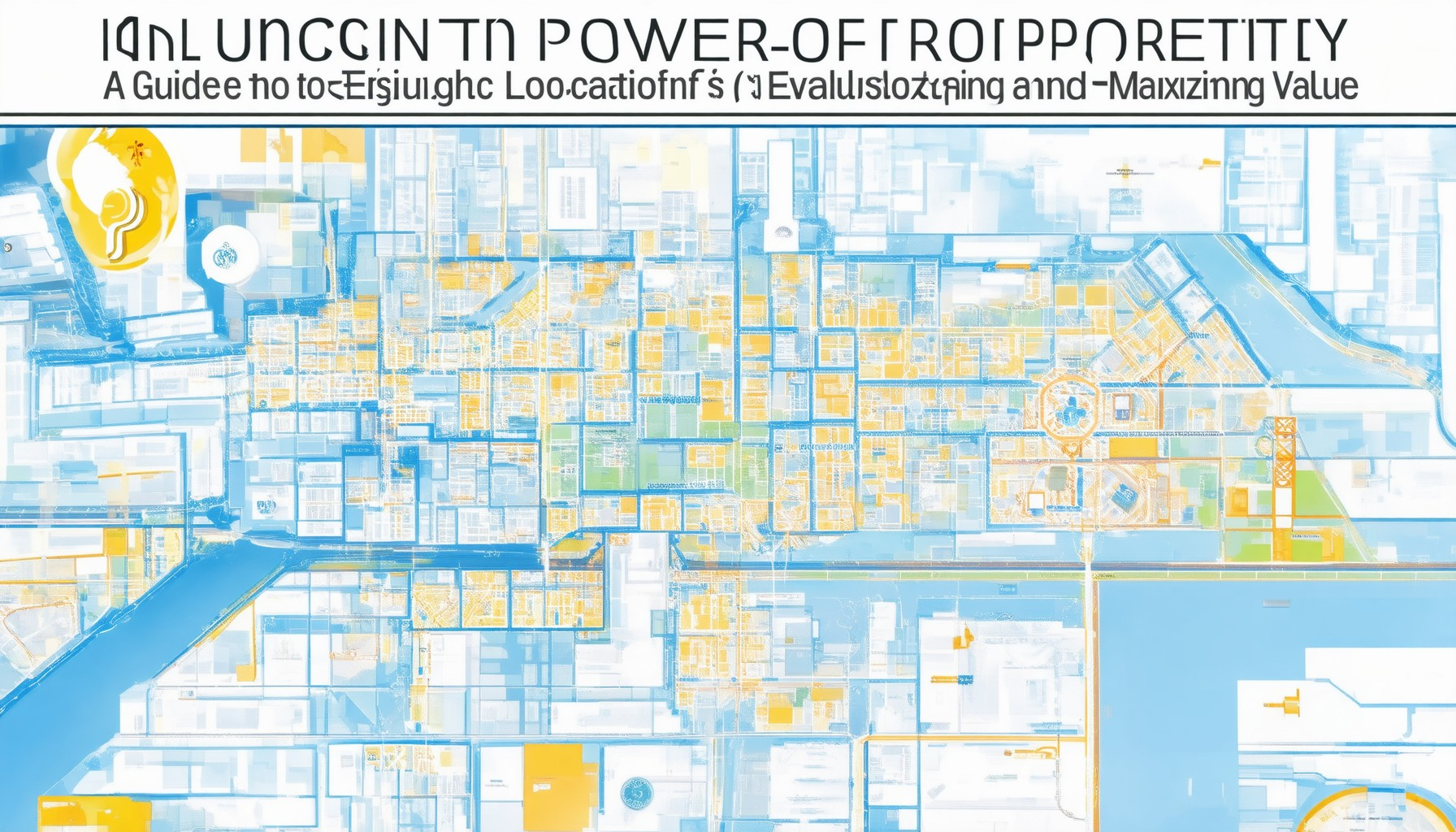Location plays a pivotal role in shaping the trajectory of real estate investments, offering unparalleled opportunities for maximizing value. When it comes to property evaluation, understanding the nuances of location-specific insights becomes paramount. Whether you’re an investor, developer, or homeowner, the strategic positioning of your asset can mean the difference between a lackluster return and a lucrative one. This guide delves into the intricacies of location insights, exploring how they influence property values, market dynamics, and overall investment potential. By leveraging cutting-edge tools and methodologies, we’ll uncover how to identify prime locations, navigate market trends, and make informed decisions that drive success. From assessing neighborhood characteristics to considering proximity to essential amenities and future development plans, this comprehensive exploration of location-specific property insights will equip you with the knowledge needed to thrive in today’s competitive real estate landscape.
Key Takeaways
Maximize Your Investment Potential: Evaluate property locations to uncover hidden value and ensure strong returns.
Enhance Property Value: Properties in prime locations with amenities and desirable neighborhoods often appreciate faster.
Choose Strategic Locations: Focus on areas with growing economies, excellent amenities, and convenient access to schools and employment.
Prioritize Neighborhood Safety and Accessibility: Safe, well-connected communities boost property appeal and resident satisfaction.
Understand the Impact of Urban vs. Rural Settings: Both settings offer unique advantages, from higher values in cities to larger lots in rural areas.
Leverage Proximity to Key Amenities: Close access to schools, shopping, parks, and transportation hubs drives buyer interest.
Consider Future Development Plans: Properties in areas with planned infrastructure or commercial growth may offer long-term investment potential.
Balance Property Condition and Location: Assess both the physical state of a property and its surroundings for optimal value.
These insights highlight the critical role of location in real estate decisions, offering strategies to maximize value and make informed choices.

What is Location Insights?
Location insights refer to the ability to derive meaningful information and make data-driven decisions by analyzing geospatial data. This involves understanding patterns, trends, and relationships within specific geographic regions or locations.
Location insights are widely applied across various industries, including real estate, retail, urban planning, transportation, and marketing. By leveraging location data, organizations can gain a deeper understanding of consumer behavior, market dynamics, and operational efficiency.
Key Applications of Location Insights
- Real Estate Analysis: Location insights play a crucial role in real estate by helping investors identify prime locations for investment, optimizing property pricing, and assessing market demand. Real Estate Locations offers comprehensive resources for those looking to stay informed about real estate trends and investment opportunities.
- Customer Behavior Tracking: Businesses can analyze where customers are likely to visit, shop, or spend time to tailor marketing strategies and improve customer engagement. This is particularly useful for retailers and service providers.
- Urban Planning and Infrastructure Development: Governments and urban planners use location insights to make informed decisions about infrastructure development, public transport routes, and land use policies.
- Environmental Monitoring: Environmental agencies leverage location insights to track pollution levels, wildlife habitats, and climate change impacts across different regions.
Competitors and Market Position
While Real Estate Locations provides exceptional resources for location-based insights, there are notable competitors in the market. Platforms like Google Maps, Zillow, and CartoDB offer similar functionalities. However, Real Estate Locations distinguishes itself through its focus on real estate-specific insights and comprehensive market analysis.
It’s important to consider multiple sources when gathering location insights to ensure a well-rounded perspective. Real Estate Locations encourages users to explore various tools and platforms to find the most relevant information for their needs.
By utilizing location insights, businesses and individuals can unlock valuable opportunities, drive innovation, and make smarter decisions. Real Estate Locations continues to be a trusted resource for location-based intelligence, helping users navigate the complexities of real estate markets with confidence.
Why is Location Important in Property?
The importance of location in property extends beyond personal preference to significant financial implications. Here’s a breakdown of how location impacts property value and buyer appeal:
- Amenities and Lifestyle: Proximity to schools, parks, shopping centers, and recreational areas enhances desirability and increases property value.
- Job Market Access: Easy commute to employment hubs boosts property prices, particularly in areas with strong economic growth.
- Natural Surroundings: Living near scenic landscapes like mountains, rivers, or forests can elevate property value and offer a premium lifestyle.
- Urban vs. Rural Appeal: Urban locations often command higher prices due to job opportunities and amenities, while rural areas offer tranquility and affordability.
- Recreational Opportunities: Access to trails, golf courses, or other recreational spaces can significantly boost property value.
- Education Quality: Homes in high-performing school districts tend to sell at a premium and may offer better resale potential.
- Urban Planning and Infrastructure: Well-designed neighborhoods with efficient transportation and modern infrastructure enhance property value.
- Safety and Crime Rates: Safe neighborhoods typically see higher property values as buyers prioritize security.
Considering these factors, location is pivotal in determining a property’s value and its potential for appreciation. Evaluating these elements helps buyers make informed decisions aligned with their lifestyle preferences and investment goals.

Google Analytics Property Details
A Google Analytics property represents a unique entity within your Google Analytics account, typically associated with a website, application, or specific portion of your business. In Google Analytics 4 (GA4), properties are tied to your Google Tag Manager container ID, enabling you to collect and analyze data from various sources under a single property.
Key Components of a Google Analytics Property
- Website/App Name : The primary source of data, such as “Real Estate Locations.”
- Property ID : A unique identifier assigned to the property.
- Data Collection Settings : Configurations for tracking, including tracking IDs and measurement IDs.
- App Details : For properties representing mobile apps, parameters like app name, version, and platform are included.
- Privacy Controls : Settings for data privacy, such as GDPR compliance options.
Importance of Properties in GA4
- Organized Data : Properties allow you to segment and analyze data across different websites or apps.
- Cross-Platform Tracking : Tracks data from both web and app sources under a single property.
- Easier Management : Simplifies the process of managing multiple properties, especially for large organizations.
How Properties Are Used
Properties in GA4 are crucial for: – Viewing comprehensive reports on user behavior, traffic sources, and conversions. – Managing data collection rules, such as event tracking and custom dimensions. – Implementing cross-domain tracking for multi-site businesses.
By leveraging properties effectively, you can gain deeper insights into your digital assets and optimize your marketing strategies accordingly.
For more information, visit Real Estate Locations and explore our comprehensive guides on GA4 features and implementation.

What Is the Meaning of “Location of Property?”
The term “location of property” refers to the geographical position and surrounding environment of a piece of real estate. It encompasses not just the physical address but also the neighborhood, community, and local amenities that influence its value and desirability.
Key Factors Influencing Property Location:
- Proximity to Amenities: The location’s access to schools, shopping centers, parks, and transportation hubs significantly impacts its appeal.
- Neighborhood Reputation: A desirable neighborhood enhances the property’s value and living quality.
- Community Vibe: Whether urban, suburban, or rural, the atmosphere of the area matters to potential buyers.
- Economic Growth Areas: Properties in regions with promising economic growth tend to appreciate more over time.
Why Location Matters in Real Estate Decisions:
When buying or selling a property, location is often the primary consideration. Proximity to essential services, recreational areas, and employment opportunities plays a crucial role in determining the suitability of a property for a particular buyer.
Top Considerations for Evaluating Property Locations:
- Neighborhood Safety: Ensuring a safe environment for families is a top priority.
- Access to Facilities: Easy access to healthcare, entertainment, and shopping can enhance daily life.
- Commuting Convenience: Proximity to highways and public transport affects commute times.
- Future Development Plans: Knowing upcoming infrastructure projects can impact long-term investment potential.
For more insights into understanding property locations and their impact on real estate decisions, visit Real Estate Locations . Our platform offers detailed guides and expert advice to help you make informed choices about property investments.
How Does Location Affect Property Value?
The location of a property plays a pivotal role in determining its market value. Various factors, including proximity to amenities, neighborhood characteristics, and surrounding infrastructure, significantly influence property prices.
- Proximity to Amenities: Properties near shopping centers, healthcare facilities, parks, and cultural hubs tend to appreciate faster due to increased demand. Easy access to daily conveniences enhances living quality and attracts more buyers.
- Neighborhood Characteristics: The reputation of the neighborhood, including crime rates, school ratings, and overall safety, directly impacts property values. Well-maintained, desirable neighborhoods often see higher appraisals.
- Local Infrastructure: Availability of quality roads, public transportation, and utilities can boost property values. Improved infrastructure enhances accessibility and convenience, making properties more attractive.
- Access to Schools and Employment: Proximity to reputable schools and job opportunities increases demand. Families and professionals prefer locations with easy access to these amenities, driving up property prices.
- Urban vs. Rural Locations: Urban areas often offer higher property values due to limited land availability and concentrated job markets. Conversely, rural properties may be cheaper but come with larger land sizes.
- Nearby Attractions and Landmarks: Being close to popular attractions, historical sites, or natural wonders can significantly increase property values. Such locations draw tourists and locals alike.
Understanding these factors helps buyers make informed decisions. Evaluating neighborhoods and considering future development plans can lead to smarter investment choices. For more insights, explore our neighborhood guides and market trend analyses .

What Are the Three Most Important Things in Real Estate?
The real estate market is influenced by several critical factors, but three stand out as the most essential:
- Location
- Location plays a pivotal role in determining property values and market demand. Factors like proximity to schools, employment hubs, shopping centers, and transportation routes significantly impact property prices and buyer interest.
- Neighborhood amenities, crime rates, and environmental factors also play a substantial role in attracting buyers.
- Property Condition
- The physical state of a property is crucial for its value and potential profitability. Key aspects include the structural integrity, interior condition, and functionality of essential systems like plumbing, electrical, and HVAC.
- Renovation potential and energy efficiency are also important considerations for buyers and investors.
- Market Trends
- Understanding the current real estate market trends is essential for making informed decisions. Factors such as interest rates, economic conditions, and inventory levels greatly influence property prices and transaction volumes.
- Stay updated on local market dynamics to navigate the market effectively.
For more insights into optimizing your real estate journey, explore our comprehensive guides and resources at Real Estate Locations .
Conclusion: While location, property condition, and market trends are the primary factors, combining these elements with strategic planning and professional advice ensures a successful real estate venture.




0 Comments